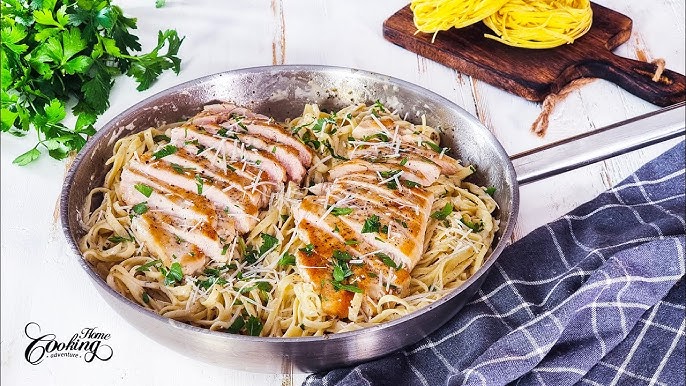Alfredo Pasta Recipe: Alfredo pasta is a creamy, rich, and indulgent Italian dish that has won hearts worldwide. It consists of pasta, traditionally fettuccine, coated in a smooth sauce made from butter, heavy cream, and Parmesan cheese. Known for its simplicity and elegance, Alfredo pasta is a favorite for quick dinners and luxurious meals alike.
The smooth texture and buttery flavor make it a go-to comfort food. Whether served as a main dish or paired with grilled chicken or shrimp, it’s always a crowd-pleaser.
The History of Alfredo Pasta
Alfredo pasta traces its roots back to early 20th-century Italy. Alfredo di Lelio, a Roman restaurateur, created this dish to please his pregnant wife, who was struggling with appetite issues. He combined butter, Parmesan cheese, and freshly cooked pasta to create a light yet satisfying meal.
His creation gained popularity when Hollywood stars Mary Pickford and Douglas Fairbanks visited his restaurant and fell in love with the dish. They introduced it to America, where it quickly gained fame and underwent modifications, such as adding heavy cream for extra richness.
Why Is Alfredo Pasta So Popular?
There’s something about Alfredo pasta that makes it irresistible. Its creamy and cheesy texture appeals to all ages. It’s easy to make, requires minimal ingredients, and can be customized with proteins, vegetables, or herbs to suit personal preferences.
Moreover, it’s versatile—whether you’re looking for a quick weeknight meal or something fancy to impress guests, Alfredo pasta fits the bill. Its rich flavor and velvety sauce make it a staple in Italian-American cuisine.
Key Ingredients Needed for Alfredo Pasta
To make the perfect Alfredo pasta, you’ll need:
- Pasta: Traditionally, fettuccine works best, but you can also use penne, spaghetti, or linguine.
- Butter: Adds richness and flavor.
- Heavy Cream: Provides the creamy texture.
- Parmesan Cheese: The star ingredient for a sharp, nutty flavor.
- Garlic: Adds depth to the sauce.
- Salt and Pepper: To enhance the taste.
- Fresh Parsley: For garnish.
Optional ingredients include chicken, shrimp, mushrooms, or spinach for added variety.
Types of Pasta You Can Use for Alfredo
While fettuccine is the traditional choice, other pasta types can also complement the sauce.
- Penne: Its hollow shape captures the sauce well.
- Spaghetti: A thinner option for a lighter feel.
- Linguine: Slightly wider than spaghetti, ideal for creamy sauces.
- Tagliatelle: Another flat pasta similar to fettuccine.
Each type brings a unique texture, allowing you to experiment based on your preferences.
Preparing Alfredo Pasta – Step-by-Step Guide
Step 1: Gather All the Ingredients
Before starting, ensure all your ingredients are prepped and measured. Having everything ready speeds up the cooking process and prevents mistakes.
Ingredients Checklist:
- 250g fettuccine (or preferred pasta)
- 1 cup heavy cream
- 1/2 cup butter
- 1 cup grated Parmesan cheese
- 2 cloves garlic, minced
- Salt and pepper to taste
- Fresh parsley for garnish
Pro Tip: Use high-quality Parmesan cheese for the best flavor. Pre-grated cheese may not melt as smoothly as freshly grated.
Step 2: Cook the Pasta to Perfection
Choosing the Right Pasta
Fettuccine is the classic choice, but penne or linguine also work well. Opt for durum wheat pasta for better texture and flavor.
Boiling Tips for Perfect Texture
- Boil water in a large pot with a generous amount of salt.
- Add pasta and stir occasionally to prevent sticking.
- Cook until al dente—firm but cooked through. Refer to the package for timing.
Pro Tip: Save 1 cup of pasta water before draining. It can be used later to adjust the sauce consistency.
Step 3: Make the Alfredo Sauce from Scratch
Using Heavy Cream and Butter
- Melt butter in a large pan over medium heat.
- Add minced garlic and sauté until fragrant, about 1 minute.
- Pour in heavy cream and stir continuously.
The Secret to a Creamy Texture
- Slowly add grated Parmesan cheese while stirring to avoid lumps.
- Cook on low heat until the sauce thickens.
Pro Tip: Avoid boiling the sauce as it can cause the cream to curdle.
Step 4: Combine the Pasta and Sauce
Mixing Techniques for Even Coating
- Add the cooked pasta to the pan with the sauce.
- Toss gently until the pasta is fully coated. Use tongs for easier mixing.
Adding Seasoning for Extra Flavor
- Sprinkle salt and pepper to taste.
- For a hint of spice, add a pinch of red pepper flakes.
Pro Tip: Use reserved pasta water if the sauce feels too thick.
Step 5: Garnish and Serve
Best Garnishes for Alfredo Pasta
- Freshly chopped parsley for color.
- Grated Parmesan for extra cheesiness.
- Cracked black pepper for aroma.
Plating Tips for Presentation
- Twirl pasta into nests for a restaurant-like look.
- Serve in white plates to highlight the creamy sauce.
Enhancing Alfredo Pasta
Adding Proteins: Chicken, Shrimp, or Bacon
One of the best ways to elevate Alfredo pasta is by adding proteins. This not only enhances the flavor but also makes the dish more filling and balanced.
- Chicken Alfredo: Grilled or pan-seared chicken breasts are a classic addition. Slice them into thin strips and lay them over the pasta, or mix the pieces directly into the sauce. Marinating the chicken in garlic, lemon, and Italian herbs adds extra flavor.
- Shrimp Alfredo: Shrimp is a quick-cooking protein that pairs beautifully with Alfredo sauce. Sauté shrimp in butter and garlic for a rich flavor, and toss them into the pasta just before serving.
- Bacon Alfredo: Crumbled crispy bacon or pancetta adds a smoky touch. Sprinkle it on top for texture and flavor bursts.
Pro Tip:
You can also experiment with grilled salmon, sausage, or even shredded rotisserie chicken for quick variations.
Vegetable Variations for Alfredo Pasta
If you want to lighten up your Alfredo pasta, adding vegetables is a fantastic idea.
- Broccoli and Spinach: Blanched broccoli florets or wilted spinach add vibrant color and nutrition without overpowering the sauce.
- Mushrooms and Peas: Sautéed mushrooms bring earthiness, while peas add sweetness and texture.
- Zucchini and Asparagus: Thinly sliced zucchini or grilled asparagus spears make a great seasonal addition.
Pro Tip:
Cook vegetables until tender but still crisp to preserve their freshness and texture.
Making It Healthier with Low-Fat Options
Love Alfredo pasta but watching your calories? Here’s how you can make it healthier:
- Use Milk Instead of Cream: Substitute heavy cream with whole milk or a mix of milk and Greek yogurt for a lighter sauce.
- Reduce Butter: Cut down the butter quantity and replace it with olive oil for a healthier fat option.
- Low-Fat Cheese: Opt for reduced-fat Parmesan or nutritional yeast as a substitute for the traditional cheese.
- Add More Vegetables: Increase the vegetable content to make the dish fiber-rich and more filling without adding too many calories.
Pro Tip:
Blend steamed cauliflower into the sauce for added creaminess without the extra fat!
Vegan Alfredo Pasta Alternatives
For plant-based eaters, Alfredo pasta can be adapted into a vegan-friendly version without sacrificing flavor.
- Dairy-Free Cream Alternatives: Use cashew cream, almond milk, or coconut cream for the base.
- Vegan Cheese: Nutritional yeast or vegan Parmesan works as a perfect replacement for traditional cheese.
- Plant-Based Butter: Substitute regular butter with vegan butter or olive oil.
- Tofu or Tempeh: For added protein, toss in cubes of grilled tofu or tempeh.
Pro Tip:
A blend of soaked cashews and almond milk, blended with garlic and lemon juice, makes an incredibly creamy and flavorful vegan Alfredo sauce.
Pairing Alfredo Pasta with Side Dishes
Alfredo pasta pairs wonderfully with a variety of side dishes to create a complete meal.
- Garlic Bread: The buttery, crispy texture complements the creamy pasta perfectly.
- Caesar Salad: A crunchy, tangy Caesar salad balances out the richness of Alfredo pasta.
- Roasted Vegetables: Oven-roasted veggies like Brussels sprouts, carrots, or zucchini add a touch of sweetness and crunch.
- Soup Options: A light soup, such as tomato basil or minestrone, serves as a warm and comforting starter.
Pro Tip:
Choose sides that contrast the creamy texture of Alfredo pasta to keep the meal balanced and enjoyable.
Tips and Tricks for Perfect Alfredo Pasta
Common Mistakes to Avoid
Even experienced cooks can sometimes make errors while preparing Alfredo pasta. Here are a few things to watch out for:
- Overcooking the Pasta: Always cook pasta al dente since it continues to soften when mixed with the sauce.
- Curdling Sauce: Keep the heat low when adding cream and cheese to avoid separation.
- Using Pre-Grated Cheese: Freshly grated Parmesan melts better and provides a smoother texture.
- Overcrowding the Pan: Mix pasta and sauce in small batches to ensure even coating.
Storing and Reheating Alfredo Pasta
Alfredo pasta tastes best when served fresh, but it can be stored and reheated if needed.
- Storage: Store leftovers in an airtight container in the refrigerator for up to 3 days.
- Reheating: Warm the pasta gently in a saucepan over low heat. Add a splash of milk or cream to revive the sauce’s consistency. Avoid microwaving, as it may cause the sauce to separate.
Pro Tip:
To avoid drying out, stir frequently while reheating and add extra cheese for a fresh flavor.
Using Pre-Made Sauce vs. Homemade Sauce
While pre-made Alfredo sauces are convenient, homemade sauce offers better flavor and control over ingredients.
- Pre-Made Sauce: Quick and easy, ideal for busy weeknights. Look for high-quality options without preservatives.
- Homemade Sauce: Allows customization of flavors, thickness, and richness.
How to Make Alfredo Sauce Thicker or Thinner
Adjusting the consistency of Alfredo sauce is simple:
- Thicker Sauce: Add more Parmesan cheese or simmer the sauce longer to reduce moisture.
- Thinner Sauce: Stir in some reserved pasta water or milk to loosen it up.
Flavor Variations and Creative Twists
Alfredo pasta can be customized in countless ways:
- Spicy Alfredo: Add red pepper flakes or a dash of cayenne pepper.
- Herb-Infused Alfredo: Stir in basil, thyme, or oregano for added aroma.
- Truffle Alfredo: Drizzle with truffle oil for a luxurious finish.
- Lemon Alfredo: Squeeze in lemon juice and zest for a refreshing touch.
FAQs about Alfredo Pasta Recipe
What ingredients are needed for Alfredo pasta?
To make a classic Alfredo pasta, you will need simple ingredients: fettuccine pasta, heavy cream, butter, and Parmesan cheese. For enhanced flavor, you can add garlic, salt, pepper, and a touch of nutmeg.
How do I make Alfredo sauce creamy without it separating?
To prevent your Alfredo sauce from separating, maintain a low and gentle heat when adding the cheese to the cream and butter mixture. Stir continuously and ensure the cheese is grated finely for smoother melting.
Can I make Alfredo pasta ahead of time?
Alfredo pasta is best served fresh, but if you need to prepare it ahead, cook the pasta slightly less than al dente and mix with a little oil to prevent sticking. Reheat gently, adding a splash of cream to refresh the sauce.
Is there a lighter alternative to traditional Alfredo sauce?
Yes, for a healthier version, you can substitute heavy cream with low-fat milk thickened with a small amount of flour or cornstarch. Add light cream cheese for creaminess without the extra calories.
What proteins go well with Alfredo pasta?
Chicken, shrimp, or salmon are excellent protein choices to complement Alfredo pasta. Ensure these proteins are well-seasoned and cooked before adding to the pasta for the best results.
How can I store leftover Alfredo pasta?
Leftover Alfredo pasta can be stored in an airtight container in the refrigerator for up to three days. Reheat on the stove over low heat, adding a bit of cream or milk to regain its creamy texture.
Can Alfredo pasta be frozen?
Freezing Alfredo pasta is possible but not recommended as the cream-based sauce may separate and become grainy when thawed. If you must freeze, store in airtight containers and reheat slowly while stirring frequently to help maintain the sauce’s texture.
Conclusion
Alfredo pasta is the ultimate comfort food that’s both luxurious and surprisingly easy to make at home. From boiling the pasta to preparing the rich, creamy sauce, this guide has walked you through every step. Whether you stick to the classic recipe or customize it with proteins and veggies, Alfredo pasta never fails to impress.
By following these tips, you can create restaurant-quality Alfredo pasta in your kitchen, perfect for any occasion. Now that you know the secrets to making this creamy delight, it’s time to impress your family and friends with your culinary skills.



